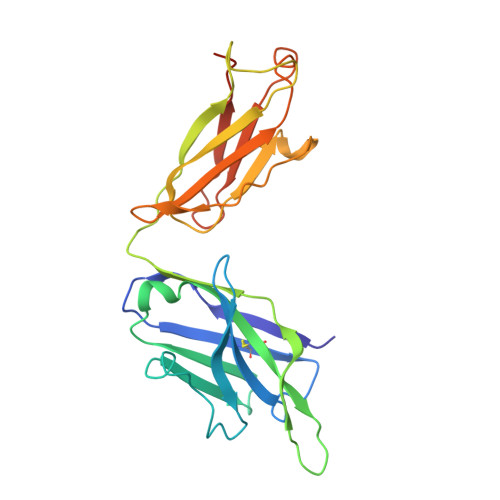A rare B cell clonotype imprinted by ancestral SARS-CoV-2 develops cross-sarbecovirus neutralization in immune recalls.
Chen, X., Li, L., Du, R., Wang, Z., Li, Y., Sun, Y., Qin, R., Feng, H., Hu, L., Chen, X., Lu, M., Huang, X., Wang, H., Jiang, L., Zuo, T.(2025) Cell Rep 44: 115964-115964
- PubMed: 40616841
- DOI: https://doi.org/10.1016/j.celrep.2025.115964
- Primary Citation of Related Structures:
9UXD, 9UXE - PubMed Abstract:
The ultimate potential of B cells imprinted by ancestral SARS-CoV-2 in developing neutralizing breadth and potency remains to be explored. Here, we longitudinally tracked B cells that recognize the wild-type spike in two individuals who were repeatedly infected by Omicron variants after receiving prototype mRNA vaccines. Functional and genetic analysis of 632 monoclonal antibodies (mAbs) from those B cells reveals that mAbs cloned after a second infection have dramatically enhanced neutralizing breadth and potency due to immune recalls. Among the eleven mAbs that broadly neutralize SARS-CoV-2 variants from the wild type to KP.3, five mAbs are classified into public clonotypes encoded by IGHV3-53 or IGHV3-66, whereas the rest belong to a rare clonotype encoded by IGHV3-74. Notably, IGHV3-74 mAbs can also potently neutralize other sarbecoviruses by targeting a non-dominant epitope partially overlapping with receptor-binding domain (RBD)-3 and RBD-5. These results support that ancestral SARS-CoV-2 immune imprinting can be harnessed in developing pan-SARS-CoV-2 and even cross-sarbecovirus vaccines.
- Laboratory of Immunoengineering, Institute of Health and Medical Technology, Hefei Institutes of Physical Science, Chinese Academy of Sciences, Hefei 230031, China; University of Science and Technology of China, Hefei 230026, China.
Organizational Affiliation:





















